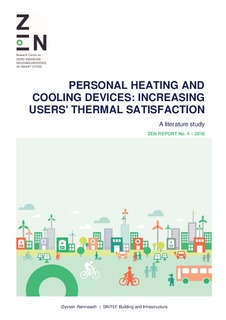| dc.description.abstract | This report is a part of Work Package 3 Responsive and Energy Efficient buildings. The goal for WP 3 is to create cost effective, responsive, resource and energy efficient buildings by developing low carbon technologies and construction systems based on lifecycle design strategies. As conventional HVAC systems can only make most users satisfied with their thermal environment, there has recently been a lot of research into personal climatization systems. The aim of this literature study was to investigate whether personal heating and cooling solutions could contribute to make all users satisfied with their thermal environment. Potential energy savings are considered a bonus, but was also included in the evaluation of the literature on the subject. Almost all of the articles reviewed in this report found that the personal climatization devices significantly improved thermal sensation and thermal comfort for the users. For both heating and cooling it was found that combining personal comfort devices resulted in higher comfort improvement and higher energy saving potential. The devices also made it possible to achieve thermal comfort outside the traditional heating and cooling setpoints, thus making it possible to extend the thermal dead-band of buildings, which could lead to substantial energy savings. There are however still some aspects of personal climatization systems where there is suggested further research, and these personal climatization systems are still not commercially available. | |
| dc.description.sponsorship | Acknowledgements. This report has been written within the Research Centre on Zero Emission Neighbourhoods in Smart Cities (FME ZEN). The authors gratefully acknowledge the support from the Research Council of Norway, the municipalities of Oslo, Bergen, Trondheim, Bodø, Bærum, Elverum and Steinkjer, Sør-Trøndelag county, Norwegian Directorate for Public Construction and Property Management, Norwegian Water Resources and Energy Directorate, Norwegian Building Authority, ByBo, Elverum Tomteselskap, TOBB, Snøhetta, ÅF Engineering AS , Asplan Viak, Multiconsult, Sweco, Civitas, FutureBuilt, Hunton, Moelven, Norcem, Skanska, GK, Caverion, Nord-Trøndelag Elektrisitetsverk - Energi, Numascale, Smart Grid Services Cluster, Statkraft Varme, Energy Norway and Norsk Fjernvarme. | |
